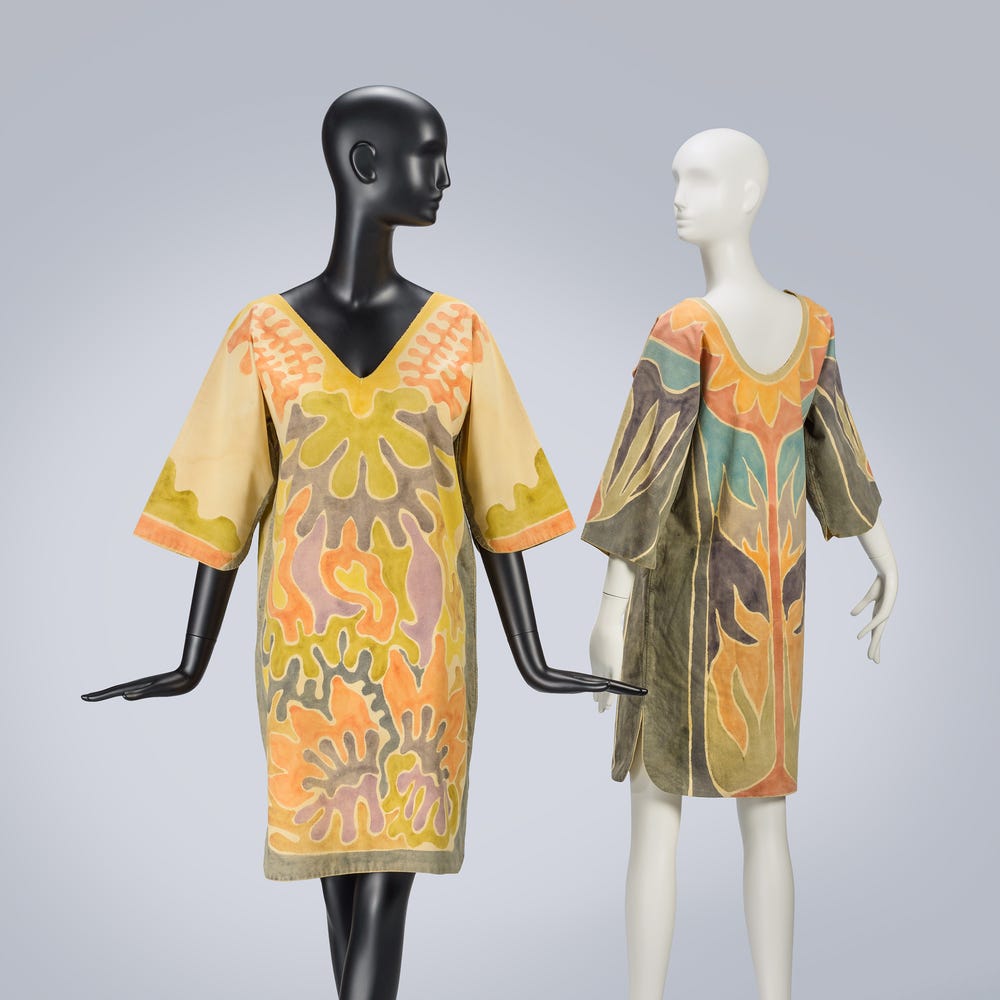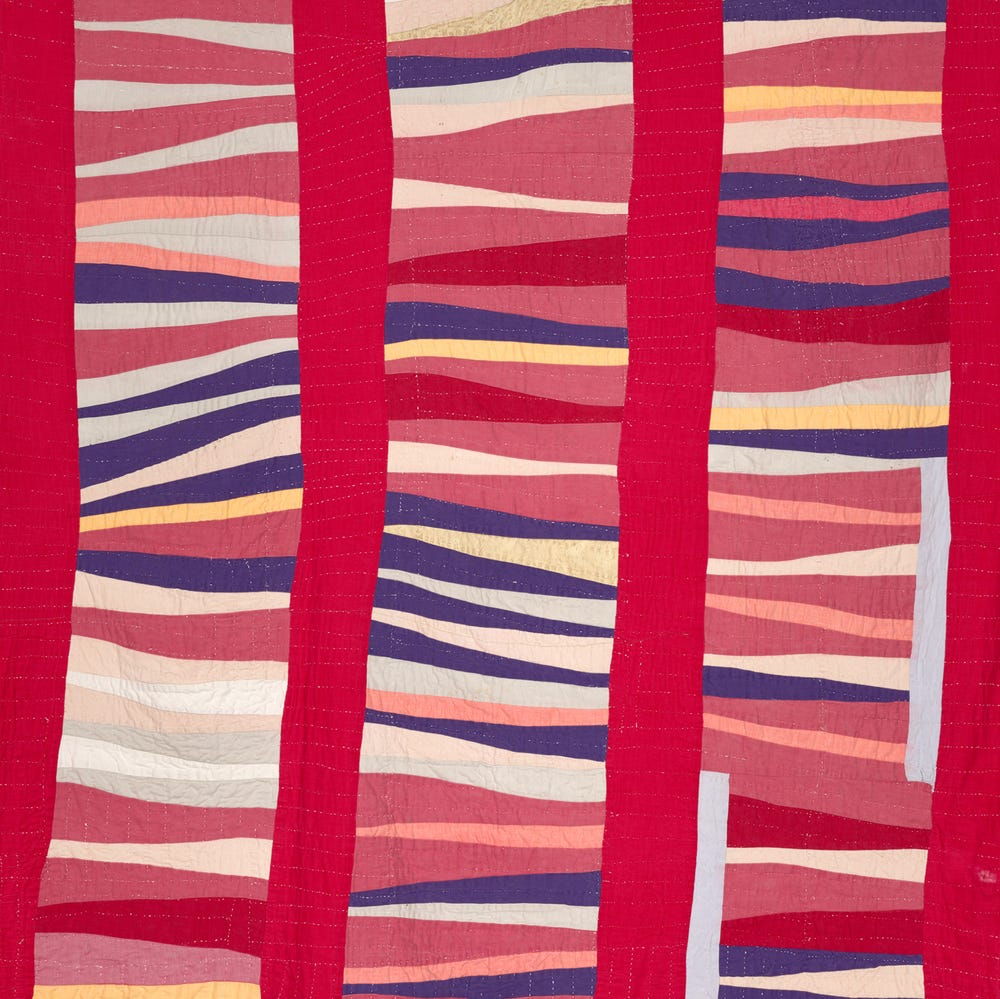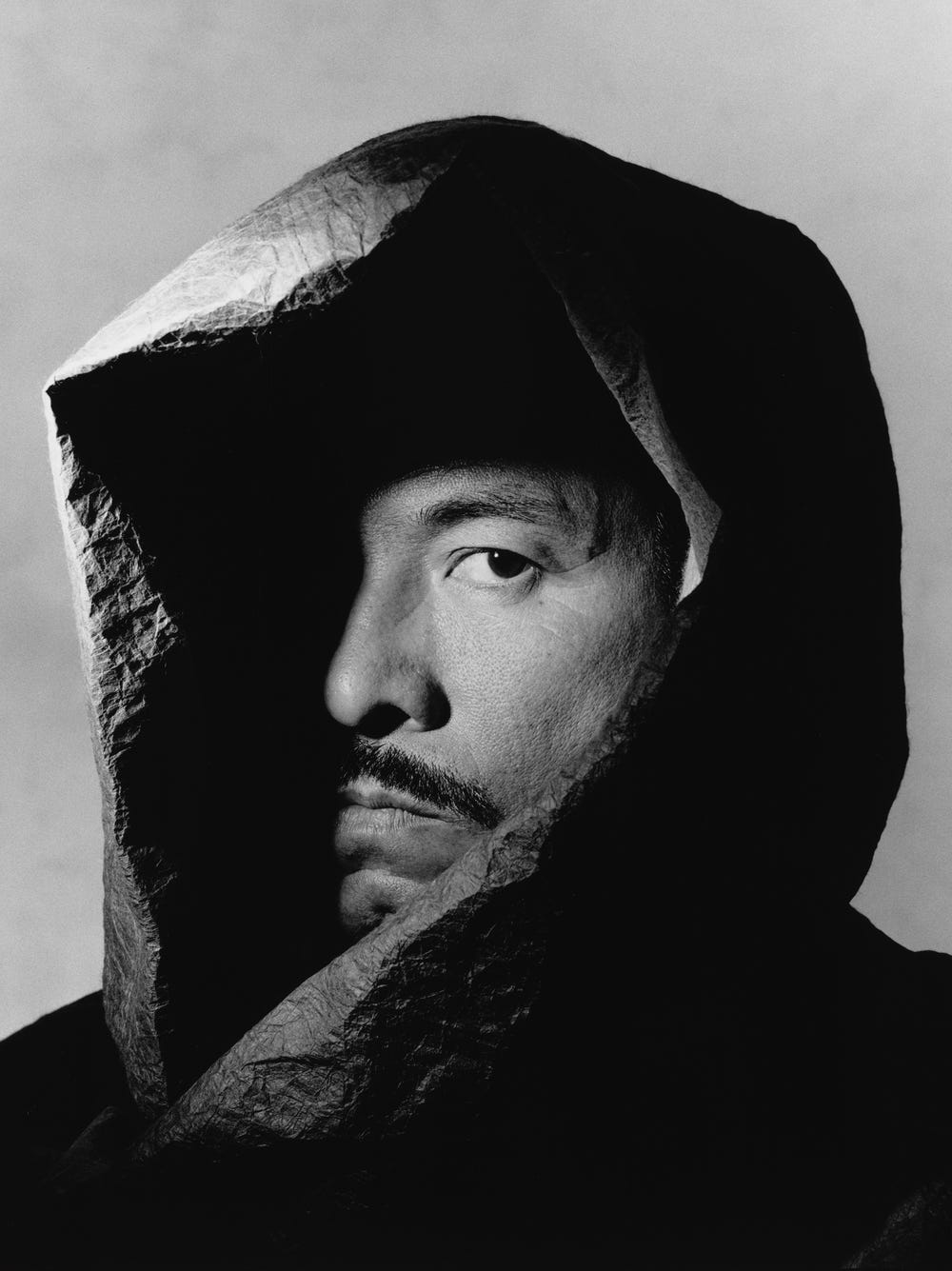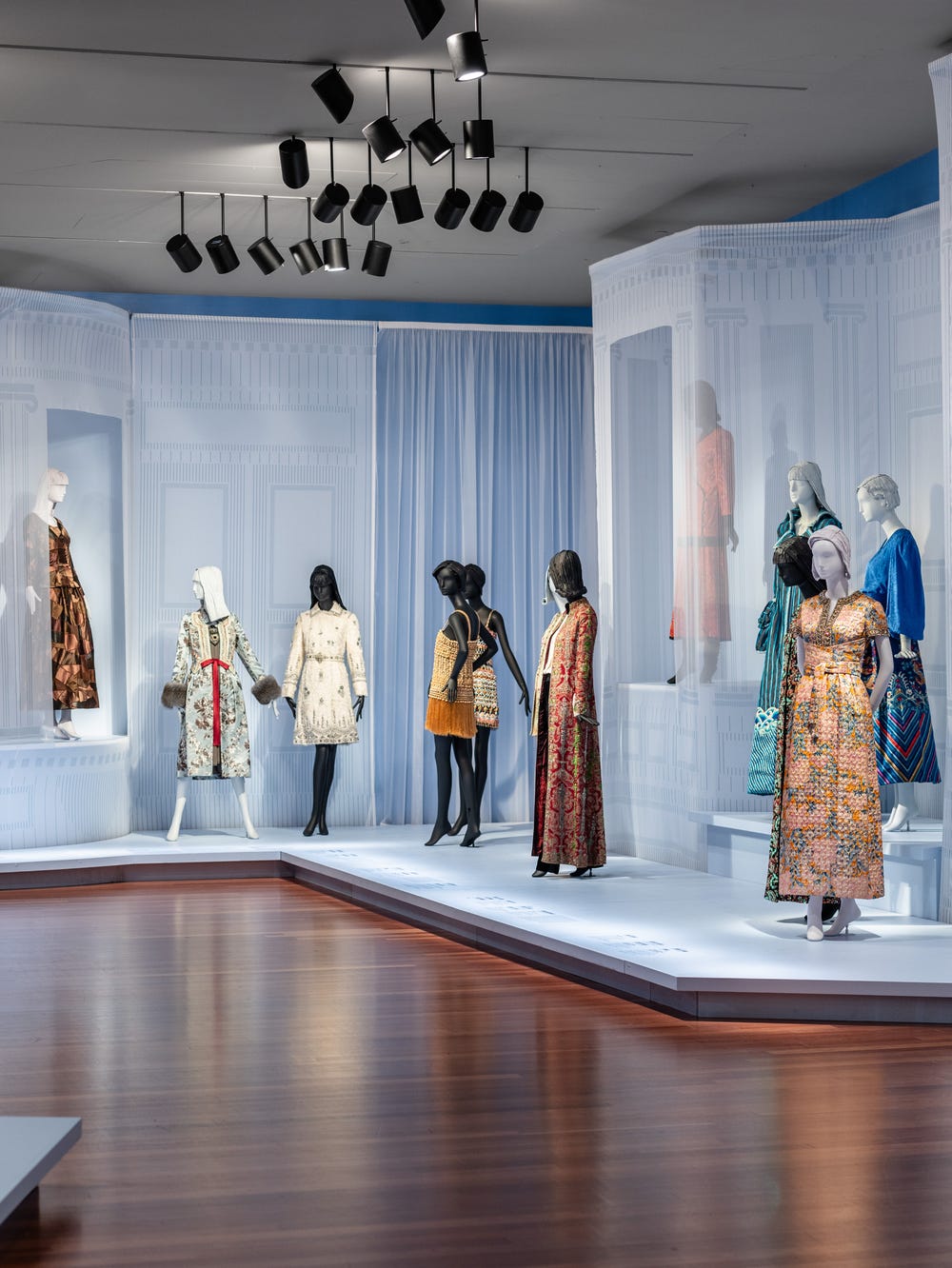Celebrating “Patrick Kelly: Runway of Love”
By Laura L. Camerlengo in conversation with Dilys E. Blum
October 25, 2021
On Saturday, October 23, Patrick Kelly: Runway of Love opened at the de Young museum. This exhibition celebrates the career and legacy of Black fashion designer Patrick Kelly (1954–1990). Kelly drew upon his childhood in the American South, his African American heritage, his experiences in the club and gay cultural scenes in New York and Paris, and muses from fashion, art, and Black history to create lighthearted yet sophisticated designs that pushed racial and cultural boundaries. The Museums’ exhibition situates Kelly and his work in the broader context of art and fashion history by exploring the inspirations behind his designs, his significant collection of racist memorabilia (whose images he wrested to tell his own story), and footage from his exuberant and groundbreaking fashion shows. Patrick Kelly: Runway of Love was first presented by the Philadelphia Museum of Art in 2014, where it was organized by Dilys E. Blum, The Jack M. and Annette Y. Friedland Senior Curator of Costume and Textiles, with the late Monica E. Brown, senior collections assistant, and Laura L. Camerlengo, former exhibitions assistant.
In this interview, Camerlengo—now Associate Curator of Costume and Textile Arts, Fine Arts Museums of San Francisco, and presenting curator, Patrick Kelly: Runway of Love—speaks with Blum to discuss Patrick Kelly’s early professional experiences and training, the varied sources of inspiration for his designs, and the impact of presenting Runway of Love at this time.
LLC: Patrick Kelly was bitten by the fashion bug as a child. Can you tell us how his interest was sparked?
DEB: Patrick Kelly credited his grandmother, Ethel, with introducing him to high fashion through the Vogue and Harper’s Bazaar magazines given to her by her white employers. Her observation that no Black women were featured [in the magazines] sparked the “fashion bug” in the six-year-old Kelly, who confidently declared that he would design clothes for all women. He acknowledged his grandmother’s own style as being the “backbone of my taste.” As a child he especially looked forward to Sundays, when she and her friends in their church dresses formed an impromptu fashion show. Their outfits were a continuing influence on Kelly, and their sartorial choices resonated throughout his collections. While his mother taught him to draw and an aunt [taught him] to sew, it was his grandmother who encouraged Kelly’s creativity, advising him that “a sore thumb stands out.”
LLC: Patrick Kelly had been working as an independent fashion designer for many years prior to launching his label in Paris. In fact, this is something that you explore in your catalogue essay. Could you tell us about his early fashion practice?
DEB: One of Patrick Kelly’s cousins recalled that as a child he was always designing clothes for his dolls. As a teenager, Kelly designed for his school friends and others, and while a student at Jackson State University, he also styled pageants. In 1974 he moved to Atlanta and opened a small shop that sold vintage clothing, and his own designs sewn by a local dressmaker. He also designed window displays for the newly opened Saint Laurent Rive Gauche boutique, which provided an opportunity to study the ready-to-wear collections of Paris couturier Yves Saint Laurent. Kelly participated in many local fashion shows, one of which featured the famous Black American supermodel Pat Cleveland. She encouraged him to move to New York to attend Parsons School of Design. An indifferent student, he spent more time dancing at Paradise Garage than studying while also channeling his creativity into dressing its “club kids” in his latest designs.
Patrick Kelly and David Spada. Woman’s Ensemble: Bra Top and Banana Skirt, Fall/Winter 1986. Worn by Pat Cleveland. Yellow and green plastic, pink metal wire, black synthetic rubber. Bra Top: 5 × 10 1/2 × 2 inches (12.7 × 26.7 × 5.1 cm) Banana Skirt - Laying Flat: 27 × 9 inches (68.6 × 22.9 cm). Philadelphia Museum of Art: Gift of Bjorn Guil Amelan and Bill T. Jones in honor of Monica Brown, 2015, 2015-201-38a,b. Image courtesy of the Philadelphia Museum of Art
Patrick Kelly was frustrated by the lack of opportunities in New York’s fashion industry and reconnected with Pat Cleveland through his roommate. She suggested he try Paris and anonymously provided him with a plane ticket. He left New York toward the end of 1979 and found a job designing costumes for the legendary nightclub Le Palace, which was patronized by a “who’s who” of Paris fashion elite, from Sonia Rykiel to Yves Saint Laurent. He briefly joined Paco Rabanne’s haute-couture atelier, but was forced to leave when he was hospitalized with Crohn’s disease. Kelly was reluctant to talk about his freelance work, which for the most part he carried out anonymously. His first paid project was a sweater collection in 1983 for the Italian fashion house Roberta di Camerino. The introduction was facilitated by famed runway show producer Audrey Smaltz, who had met Kelly as a teenager in 1970 at her first Ebony Fashion Fair fashion show where she was its fashion coordinator and commentator until 1977. Later she coordinated Kelly’s Paris shows. The Italian knitwear project was followed by a fashion collaboration in 1983 with the Turin-based design group Studio Invenzione founded by partners Marco Fattuma Maò, an artist, and architect Loredana Dionigio. Their experimental project was exhibited at a well-known contemporary art gallery and later reworked as a complete fashion collection presented during Milan fashion week for Fall/Winter 1984–1985.
Patrick Kelly started selling one-seam coats—the only thing people could try on outside in the winter—on the street near the Church of Saint-Germain-des-Prés. Kelly had little money to invest, so he bought fabric at local street markets and did the sewing himself on a borrowed sewing machine. He turned out fifteen coats a day, which his model friends wore over colorful knit dresses cut directly from bolts of inexpensive tubular knit fabric that involved no sewing. In 1983, Kelly met his life and business partner, Bjorn Guil Amelan; his many freelance projects together with Amelan’s earnings as a photographer’s agent funded Kelly’s ready-to-wear collections until the business received backing from the fashion conglomerate Warnaco in 1987. Among Kelly’s freelance projects were knitwear for the Italian brand Touche for Fall/Winter 1985–1986, designs created for the luxury bathing suit label Eres, two collections for the mail-order catalogue 3 Suisses advertised with his name, Bon Magique collections produced exclusively for French Elle magazine readers, and a fifty-piece collection for woven fabrics and jeans for Benetton.
LLC: When did he formally launch his label, Patrick Kelly Paris?
DEB: The brand Patrick Kelly Paris was launched on the street in 1984. Amelan was aware of Kelly’s disappointment when the Milan collection didn’t carry his name, so he presented him with a roll of labels printed with the words “Patrick Kelly Paris.”
LLC: Could you tell us about his first official collection? What kinds of designs did it include?
DEB: Patrick Kelly’s first ready-to-wear collection was shown in March 1985 during the Fall/Winter 1985–1986 presentations. The fashion show was held above the offices for the famous boutique Victoire, located at 17 Rue du Mail, and known for launching many young designers including Azzedine Alaia and Thierry Mugler. Françoise Chassagnac, the shop’s fashion director and buyer, had earlier suggested that Kelly contact the editor in chief of French Elle, Nicole Crassat, who wasn’t afraid to court controversy by featuring unknown designers for the magazine’s editorial pages. Crassat fell in love with Kelly and his tubular knit dresses. The result was a six-page spread in the magazine’s February issue. Dawn Mello of Bergdorf Goodman special-ordered the dresses featured in Elle for the upcoming summer season. To meet the rushed deadline, Kelly sewed the dresses himself, working long into the night. Victoire offered to take on the production and shipping of the March collection in unused space on the second floor for the next two years. Kelly in turn designed exclusives for the boutique. It was Kelly’s talent and determination to succeed, coupled with the love and goodwill of his friends and supporters, that sustained Kelly during the first few years. For Kelly’s first ready-to-wear collection, models worked for free (they were paid with Kelly’s designs).
A model at the Patrick Kelly Spring 1989 show in Paris, France. Photo by PL Gould/IMAGES/Getty Images. Image courtesy of the Fine Arts Museums of San Francisco
LLC: Patrick Kelly’s designs had broad popular appeal. Clients included diverse women between the ages of thirty and fifty, among them the Hollywood and international elite, such as the iconic actor Bette Davis and Princess Diana. What was it about Patrick’s designs that made them so appealing to a variety of women?
DEB: Patrick Kelly offered Paris style at a reasonable price, and his designs were sold through the higher-end United States department stores and smaller specialty shops, and in Canada, Europe, and Japan. Kelly’s coats and suits were perfect for the woman who wanted to look professional but with a bit of an edge. His dresses and eveningwear were just avant-garde enough for the mature woman. Knit dresses contained enough Lycra to hug the body and keep their shape. The button-covered dresses were among his best sellers. Because buttons sewn onto dresses were subject to higher import duties and thus wholesale prices, Kelly resolved the issue by manufacturing plain knit dresses and including a separate bag of buttons that the purchaser could sew or pin on herself. Victoire fully produced the collections through Spring/Summer 1987, at which point they felt the collection was becoming too large for them to continue to produce. Patrick Kelly Paris then licensed the production to Perugia, Italy-based Ghinea; Ghinea produced the Fall/Winter 1987 collection. Warnaco took over when they signed an exclusive contract with Kelly for ready-to-wear sportswear, dresses, coats, jackets, and sweaters in 1987, with the first collection delivered for Spring/Summer 1988.
A model walks the runway at the Patrick Kelly Ready to Wear Spring/Summer 1989 fashion show. Photo by Victor VIRGILE/Gamma-Rapho via Getty Images. Image courtesy of the Fine Arts Museums of San Francisco
LLC: Patrick Kelly had a wide array of influences in his designs. He was inspired by his upbringing in the American South, as he was born and raised in Vicksburg, Mississippi; by his experiences in the club scenes in New York and Paris; by fashion, art, and Black histories; and also popular culture. Could you talk about these various sources of inspiration and how they manifested in his designs?
DEB: Each collection held a wealth of references that embraced Patrick Kelly’s life experiences, from his Mississippi childhood to his life in Atlanta, New York, and Paris, where he was happiest. Kelly was not shy about pushing buttons with racialized imagery and allusions and references to his own sexuality. The artwork on his fashion show invitations mirrors how he saw himself. The earliest features his lucky number, three; another, reworked from a postcard from his collection of Josephine Baker memorabilia, features the entertainer wearing her banana-skirt costume; [other invitations featured] Kelly surrounded by his enormous collection of Black dolls; and, for his last collection, Kelly provocatively dressed as a blackamoor for a Pierre et Gilles photograph.
Photograph by Oliviero Toscani. Courtesy of the Estate of Patrick Kelly. Scan by Randy Dodson / Fine Arts Museums of San Francisco
LLC: Like many designers, Patrick Kelly had certain style signatures, such as buttons. Can you tell us more about them?
DEB: The one element in Patrick Kelly’s designs that say “Patrick Kelly Paris” are his buttons. As a child, he was always losing his shirt buttons, which his grandmother replaced with miscellaneous buttons from her button jar. One day he looked down to discover that all the buttons were different colors—and a signature style was born. Buttons were incorporated into his designs from the very beginning—clear buttons marched down the front and back of tube dresses, multicolored buttons were collaged into hearts, and [buttons] formed golliwogs and abstract patterns on body-hugging wool knits. Many of his other style signatures were intentional riffs on his favorite designers, especially Yves Saint Laurent, Madam Grés, Elsa Schiaparelli, and Gabrielle “Coco” Chanel. He incorporated variations of Saint Laurent’s textiles into his collections, draped fabric around the body in honor of Madame Grés, designed gloves with red heart-shaped nails like Schiaparelli, and for his “Chanel” suits he used brightly colored tweeds with colorful oversized plastic buttons surrounded by the couturier’s signature twisted gilt ropes.
LLC: Did you always know of Patrick Kelly’s work? What inspired you to explore his career in depth?
DEB: I knew that Patrick Kelly was the first American and first Black designer inaugurated into the Chambre Syndicale, and I remembered his work from 1980s fashion magazines. But it was seeing images taken by the late Monica E. Brown, our senior collections assistant, of Thelma Golden’s show at the Brooklyn Museum in 2004 that prompted us to begin looking for designs to add to the Philadelphia Museum of Art’s collection. That year we acquired a strapless knit dress from 1986, an oversized button brooch, and one of the Black baby dolls Patrick Kelly handed out at fashion shows.
For years, Monica Brown had been researching Black designers, and she was developing drawers of information gleaned from magazines, newspapers, and fashion shows. When we discovered that the Brooklyn Museum had been storing the Patrick Kelly archive and was not planning to acquire it, Monica contacted Bjorn Amelan to indicate our interest. In 2010, we brought the entire collection to the Philadelphia Museum of Art and started the slow and lengthy process of deciding what we would want to accession. We had to work through nearly 860 full and partial garments and accessories including jewelry. Luckily, we had access to the original fashion show footage, and Monica painstakingly went through the videos, frame by frame, matching up individual garments and jewelry with runway images, and looking to Bjorn for an understanding of the finer details.
Fashion model and entertainer Grace Jones wearing a brightly colored ready-to-wear costume designed by Patrick Kelly during his Spring/Summer 1989 fashion show in Paris. Photo by Pierre Vauthey/Sygma/Sygma via Getty Images. Image courtesy of the Fine Arts Museums of San Francisco
LLC: What does the gift of the collection to a museum mean for Patrick Kelly’s legacy?
DEB: Patrick Kelly was never out of ideas and fearless about bringing up issues in the 1980s that continue to be relevant today. While they pushed boundaries with stories and themes that gave him a voice on race, racism, and sexuality, his Paris fashion shows were little understood by the audience of mostly white fashion editors and buyers. He was never heavy-handed and cloaked his observations in wit and irony. In many ways, he reminds me of the couturier Elsa Schiaparelli, Chanel’s great rival during the 1930s. Once, he slyly commented that he should call his brand “Schiaparelli by Kelly.” He greatly admired her inventiveness, wit, and irreverence. Fittingly, Kelly’s collection joins that of Schiaparelli, who donated her collection of seventy signature works to the Philadelphia Museum of Art in 1969. The Patrick Kelly collection is the largest collection by a single Black fashion designer in the United States and provides an opportunity to study his work in depth.
LLC: The original Runway of Love exhibition was on view in 2014. Why was the Philadelphia Museum of Art still interested in traveling the show after a seven-year hiatus?
DEB: We have been looking for a second venue since Patrick Kelly: Runway of Love was first exhibited in 2014. Although several museums had shown initial interest at the time, they eventually decided on exhibitions by designers that were more “glamorous” and had recognizable names. When the Fine Arts Museums of San Francisco approached us about updating the exhibition for San Francisco, we jumped at the chance. You had been a fellow and, later, an assistant in Costume and Textiles at the Philadelphia Museum of Art during the exhibition, and helped with the research and installation as well as curating a small show by an up-and-coming designer enamored with Patrick Kelly. With the Fine Arts Museums of San Francisco’s presentation, we could also publish an exhibition catalogue—which I jumped at since we had photographed and styled every work in 2014 in the hope of a future publication. The opportunity to tie it to an exhibition was ideal. Our styling reflected how Patrick Kelly’s designs were seen on the runway and when possible, we acknowledged the name of the model who originally wore it in the show.
Patrick Kelly at his Spring 1989 show in Paris, France. Photo by PL Gould/IMAGES/Getty Images. Image courtesy of the Fine Arts Museums of San Francisco
LLC: What do you hope visitors will take away from the Fine Arts Museums of San Francisco’s presentation of Patrick Kelly: Runway of Love?
DEB: I am so grateful for the opportunity to introduce Patrick Kelly to a new audience, and to look at his work through the lens of recent events. Responses to his designs are inevitably affected by our own experiences and histories, but the images he created with his fashions are more powerful than words. While some may find his work and collections of memorabilia controversial and offensive, they represented Patrick Kelly in the 1980s. He consciously pushed stereotypes and mined irony. As he reflected, “If you don’t know where you have been in your history, then you don’t know where to go.”
LLC: Just for fun—what three adjectives would you use to describe Patrick Kelly?
DEB: Lovable, joyful—and radical (chic)!
Text by Laura L. Camerlengo, associate curator of costume and textile arts, Fine Arts Museums of San Francisco, and presenting curator of Patrick Kelly: Runway of Love, with Dilys E. Blum, the Jack M. and Annette Y. Friedland senior curator of costume and textiles, Philadelphia Museum of Art, and organizing curator of Patrick Kelly: Runway of Love.
Patrick Kelly: Runway of Love is on view at the de Young museum from October 23, 2021 to April 24, 2022.
Header image: Patrick Kelly collection. Photograph by Oliviero Toscani. Courtesy of the Estate of Patrick Kelly. Scan by Randy Dodson / Fine Arts Museums of San Francisco
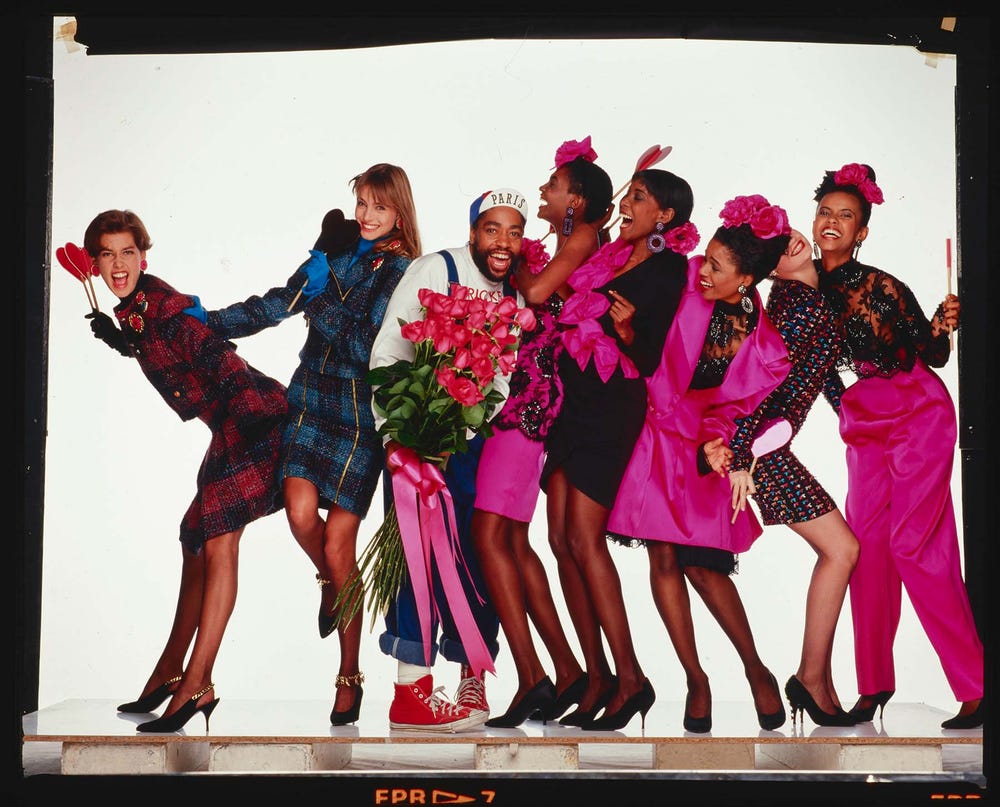
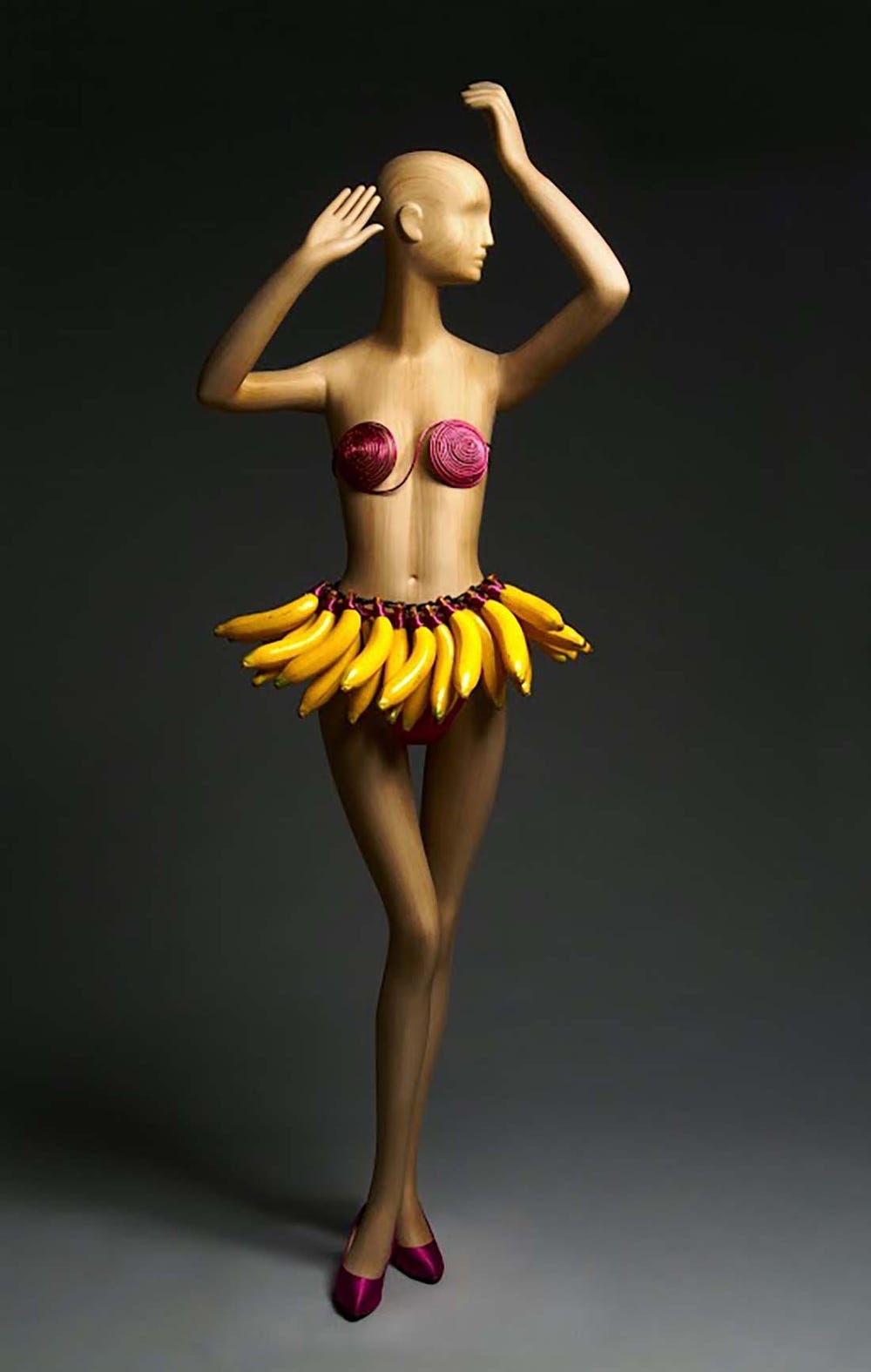
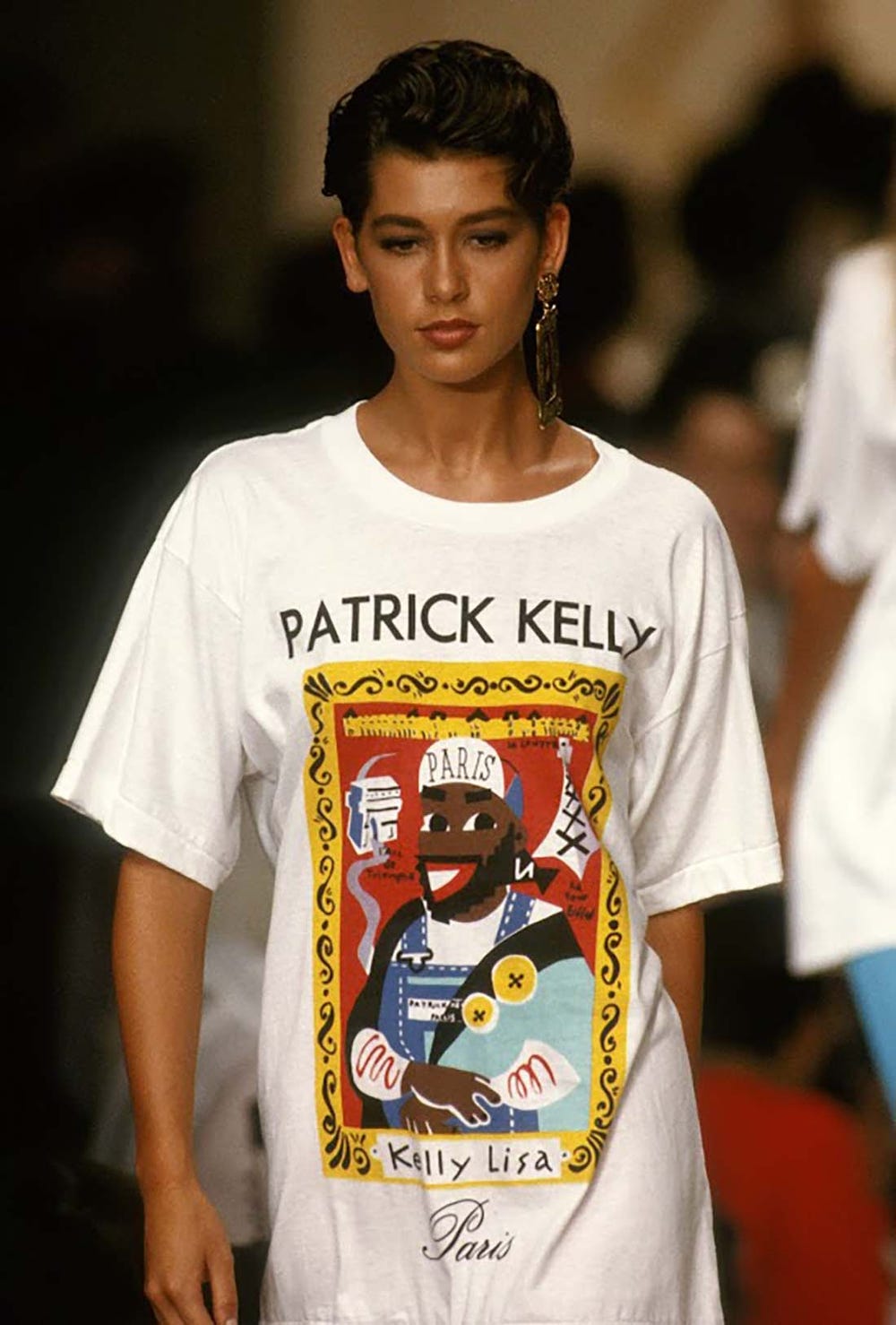
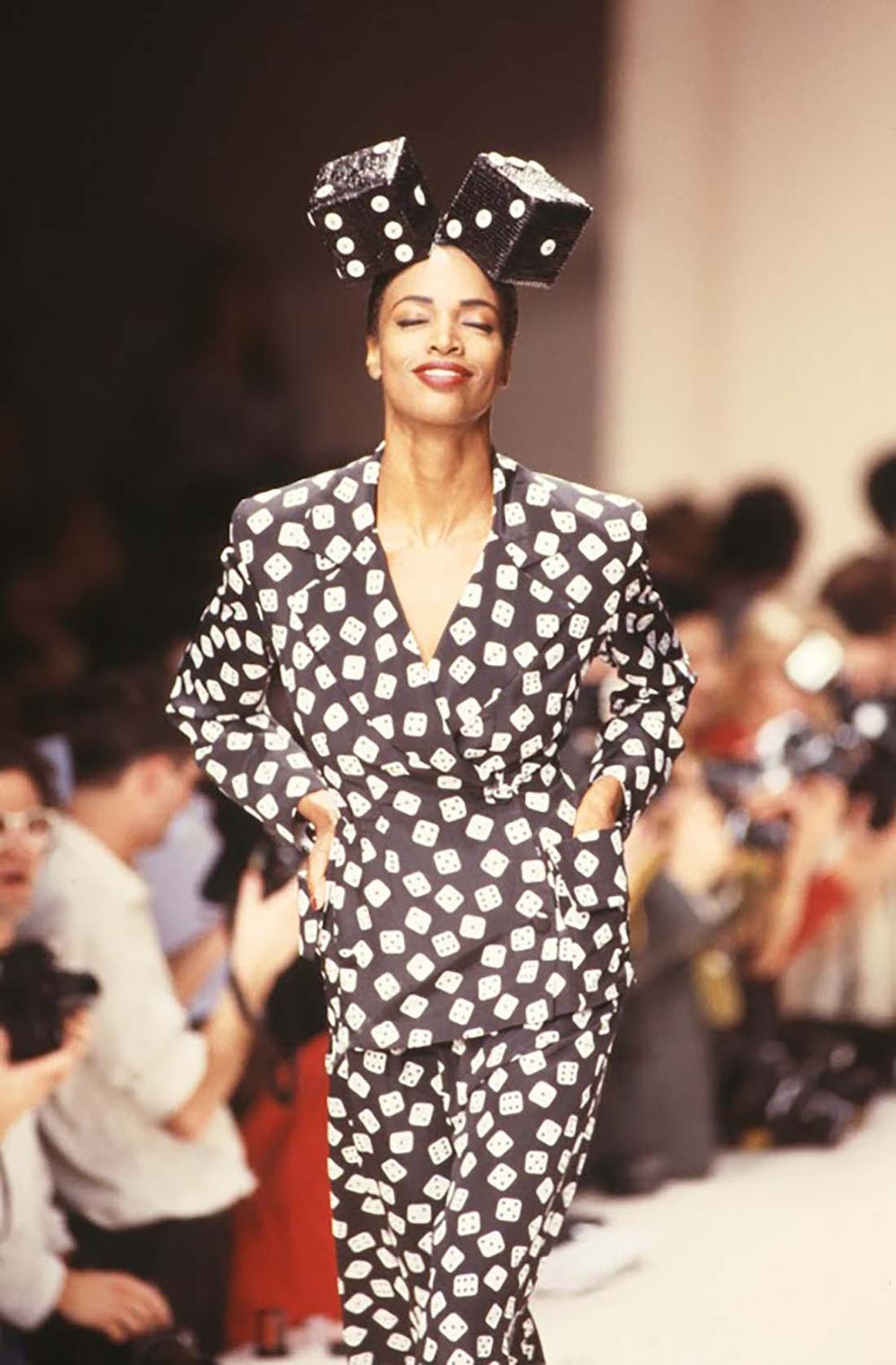
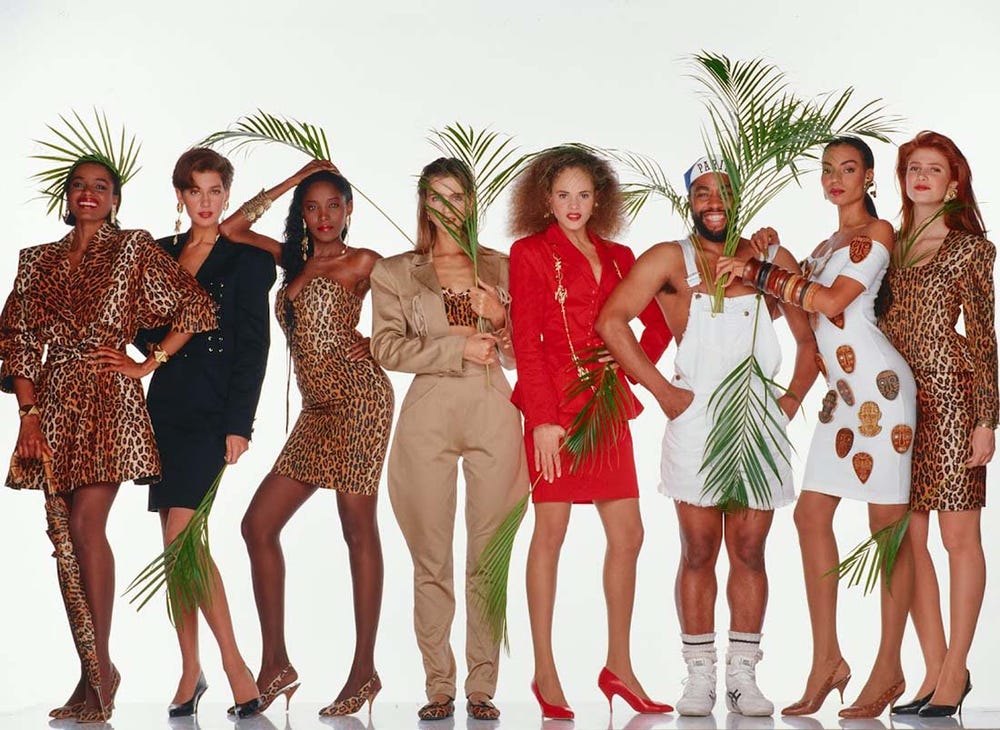
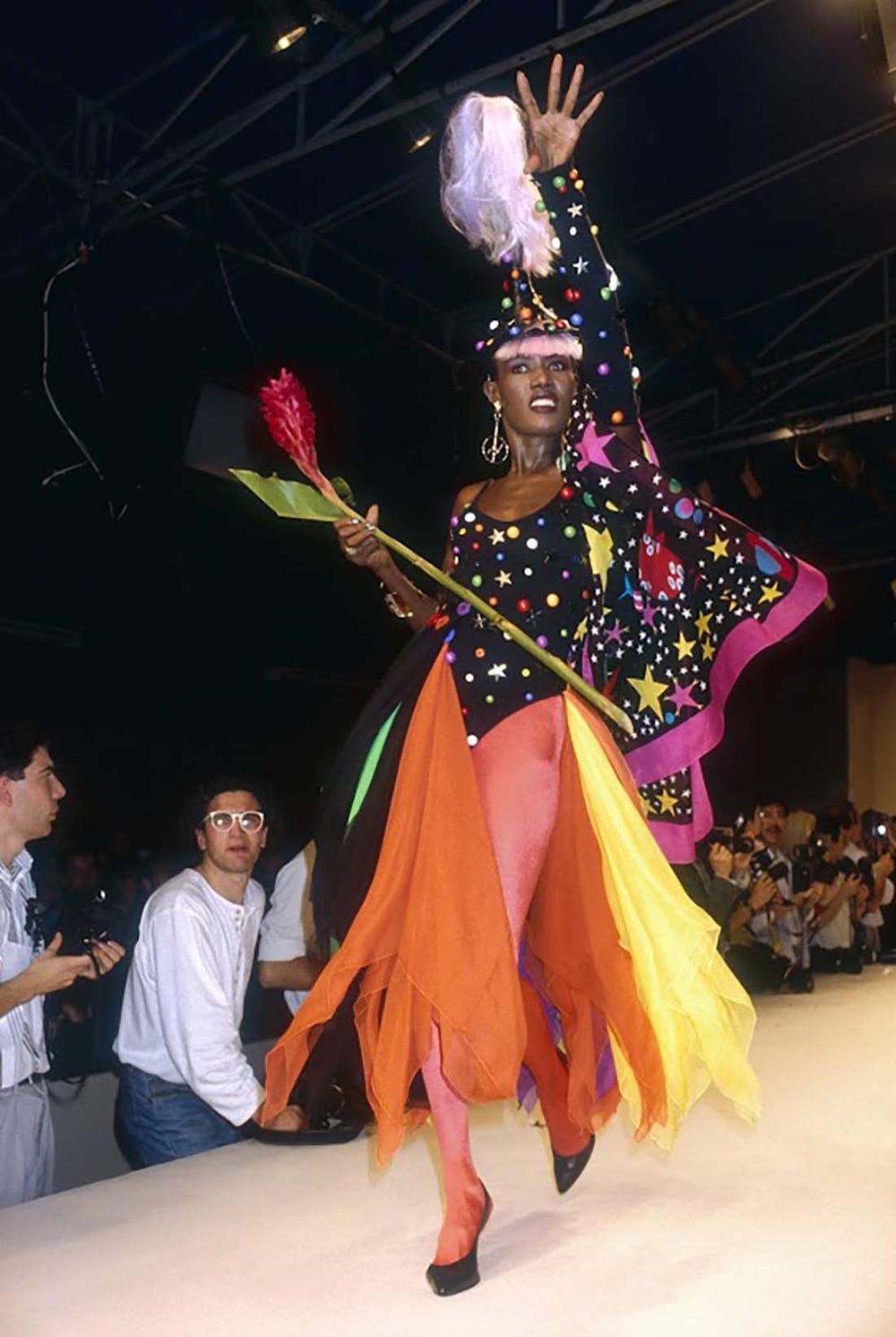
![Patrick Kelly posing with spray paint in front of a sign that reads "Patrick Kelly [heart] you"](https://www.famsf.org/storage/images/a1f4584e-b892-4148-724f-0bd42cc65aad/patrick-kelly-celebration-7.jpg?crop=1100,1629,x0,y0&format=jpg&quality=80&width=1000)
